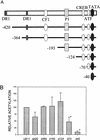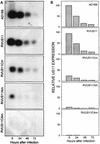Transcriptional regulation of the human cytomegalovirus US11 early gene
- PMID: 9882286
- PMCID: PMC103905
- DOI: 10.1128/JVI.73.2.863-870.1999
Transcriptional regulation of the human cytomegalovirus US11 early gene
Abstract
The human cytomegalovirus (HCMV) US11 early gene encodes a protein involved in the down-regulation of major histocompatibility complex class I cell surface expression in HCMV-infected cells. Consequently, this gene is thought to play an important role in HCMV evasion of immune recognition. In this study, we examined the transcriptional regulation of US11 gene expression. Analysis of deletions within the US11 promoter suggests that two sequence elements are important for activation by the viral immediate-early (IE) proteins. Deletion of a CREB site located at -83 relative to the cap site resulted in a reduction in promoter activity to 50% of the wild-type level. Deletion of an additional ATF site immediately upstream of the TATA box resulted in abrogation of responsiveness to the IE proteins. To confirm the role of the CREB and ATF sites within the US11 promoter, mutagenesis of these two sites, both individually and in combination, was carried out. Results indicate that both the CREB element and the ATF site were required for full promoter activity, with the ATF site critical for US11 promoter activation. The loss of transcriptional activation correlated with a loss of cellular proteins binding to the mutated US11 promoter elements. In combination with the viral IE proteins, the HCMV tegument protein pp71 (UL82) was found to up-regulate the US11 promoter by six- to sevenfold in transient assays. These results suggest that pp71 may contribute to the activation of the US11 promoter at early times after infection. Up-regulation by pp71 required the presence of the CREB and ATF sites within the US11 promoter for full activation. The role of the ATF and CREB elements in regulating US11 gene expression during viral infection was then assessed. The US11 gene is not required for replication of HCMV in tissue culture. This property was exploited to generate US11 promoter mutants regulating expression of the endogenous US11 gene in the natural genomic context. We generated recombinant HCMV that contained the US11 promoter with mutations in either the CREB or ATF element or both regulating the expression of the endogenous US11 gene. Northern blot analysis of infected cell mRNA revealed that mutation of the CREB element reduced US11 mRNA expression to approximately 25% of that of the wild-type promoter, with identical kinetics of expression. Mutation of the ATF site alone reduced US11 mRNA levels to 6% of that of the wild-type promoter, with mRNA detectable only at 8 h after infection. Mutation of both the CREB and ATF elements in the US11 promoter reduced US11 gene expression to undetectable levels. These results demonstrate that the CREB and ATF sites cooperate to regulate the US11 promoter in HCMV-infected cells.
Figures






References
-
- Boldogh I, AbuBakar S, Albrecht T. Activation of proto-oncogenes: an immediate early event in human cytomegalovirus infection. Science. 1990;247:561–564. - PubMed
-
- Britt W J, Alford C A. Cytomegalovirus. In: Fields B N, Knipe D M, Howley P M, et al., editors. Virology. 3rd ed. New York, N.Y: Raven Press; 1996. pp. 2493–2523.
Publication types
MeSH terms
Substances
Grants and funding
LinkOut - more resources
Full Text Sources
Other Literature Sources
Miscellaneous

